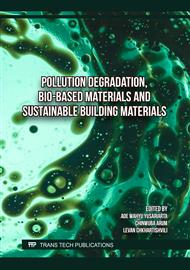[1]
B.R. Widiatmono, A.A. Sulianto, C. Debora, Biodegradabilitas bioplastik berbahan dasar limbah cair tahu dengan penguat kitosan dan plasticizer gliserol, J. Sumberdaya Alam Lingk. 8 (2021) 21-27.
DOI: 10.21776/ub.jsal.2021.008.01.3
Google Scholar
[2]
A. Rahman, K. Syamsu, Isroi, Biodegradability of bioplastic from oil palm empty fruit bunch, JPSL. 9 (2019) 259-264.
Google Scholar
[3]
Muhammad, R. Ridara, Masrullita, Sintesis bioplastik dari pati biji alpukat dengan bahan pengisi kitosan, J. Teknol. Kim. UNIMAL. 9 (2020) 01-11.
DOI: 10.29103/jtku.v9i2.3340
Google Scholar
[4]
M.R.B. Saputra, E. Supriyo, Pembuatan plastik biodegradable menggunakan pati dengan penambahan katalis ZnO dan stabilizer gliserol, PENTANA. 1 (2020) 41-51.
Google Scholar
[5]
F. Hanum, I.M.D. Kaban, M.A. Tarigan, Ekstraksi pektin dari kulit buah pisang raja (musa sapientum), Jurnal Teknik Kimia USU. 1 (2012) 21-26.
DOI: 10.32734/jtk.v1i2.1413
Google Scholar
[6]
S. Elystia, N.A.H. Hasibuan, Zultiniar, Pemanfaatan bionanomaterial chitosan dari limbah cangkang kulit udang sebagai adsorben dalam pengolahan air gambut, J. Ilmu Lingk. 3 (2022) 570-578.
DOI: 10.14710/jil.20.3.570-578
Google Scholar
[7]
A.R. Kusmiati, Nurhayati. Pemanfaatan kitosan dari cangkang udang sebagai adsorben logam berat Pb pada limbah praktikum kimia farmasi, Indones. J. Laboratory. 3 (2020) 6-14.
DOI: 10.22146/ijl.v3i1.60789
Google Scholar
[8]
S. Solekah, N. Sasria, H.A. Dewanto, Pengaruh penambahan gliserol dan kitosan kulit udang terhadap biodegradasi dan ketahanan air plastik biodegradable, Al-Kimiya: J. Ilmu Kim. Ter. 8 (2021) 80-86.
DOI: 10.15575/ak.v8i2.13917
Google Scholar
[9]
N. Sasria, Asrilsyah, M.P.D. Lubis, A. Zulfikar, R.A. Tanjung, Sintesis dan karakterisasi plastik biodegradable berbasis pati nasi aking dan kitosan cangkang udang, Teknika: J. Sains Teknol. 16 (2020) 231–236.
DOI: 10.36055/tjst.v16i2.8700
Google Scholar
[10]
N. Sasria, R. Hernando, M.P.D. Lubis, A. Zulfikar, Production of biodegradable plastics using aking rice starch and chitosan from crab shells as a substitute for conventional plastic, IOP Conf. Series: Materials Science and Engineering. 1053 (2021) 1-9.
DOI: 10.1088/1757-899x/1053/1/012079
Google Scholar
[11]
R.D.A. Putri, A. Setiawan, P. Anggraini, Effect of carboxymethyl cellulose (cmc) as biopolymers to the edible film sorghum starch hydrophobicity characteristics, AIP Conf. Proc. 1818 (2017) 1-5.
DOI: 10.1063/1.4976908
Google Scholar
[12]
A. Alfiani, N. Sasria, M.P.D. Lubis, Pengaruh carboxymethyl celullose terhadap karakteristik bioplastik menggunakan tandan kosong kelapa sawit dan pati ampas tahu, JIP. 12(2023) 12-16.
DOI: 10.36055/jip.v12i1.18932
Google Scholar
[13]
Q. Zhong, W. Xia, Physicochemical properties of edible and preservative film from chitosan/cassava starch/gelatin blend plasticized with glycerol, Food Techno. Biotechnol. 46 (2008) 262-269.
Google Scholar
[14]
Y. Tokiwa, B.P. Calabia, C. Ugwu, S. Aiba, Biodegradability of plastics, Int. J. Mol. Sci. 10 (2005) 3722-3742.
DOI: 10.3390/ijms10093722
Google Scholar
[15]
M. Gill, Bioplastic: a better alternative to plastics, Impact: IJRANSS. 2 (2014) 115-120.
Google Scholar


